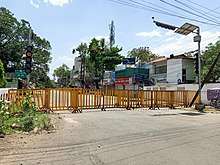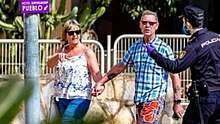Lockdown
A lockdown is a requirement for people to stay where they are, usually due to specific risks to themselves or to others if they can move freely. The term "stay-at-home" or "shelter-in-place" is often used for lockdowns that affect an area, rather than specific locations.
The term is used for a prison protocol that usually prevents people, information or objects from leaving an area. The protocol can usually only be initiated by someone in a position of authority.
A lockdown can also be used to protect people inside a facility or, for example, a computing system, from a threat or other external event. In buildings doors leading outside are usually locked so that no person may enter or exit. A full lockdown usually means that people must stay where they are and may not enter or exit a building or rooms within it, needing to go to the nearest place designated safe if not already in such a place. A drill lockdown may be held in the absence of a threat, to familiarise people with what they must do.

Types
Procedures for using both emergency and preventive lockdowns must be planned.[1]
Preventive lockdown
A preventive lockdown is a preemptive action plan implemented to address an unusual scenario or a weakness in system to preempt any danger to ensure the safety and security of people, organisation and system. The focus for preventive actions is to avoid dangers and risks arising from the nonconformances to the normal circumstances, but also commonly includes improvements in efficiency.
Preventive lockdowns are preemptive lockdowns to mitigate risk. Most organisations plan for the emergency lockdowns but fail to plan for other situations which might quickly degrade to dangerous levels. These protocols must be based on the type of threat, and should be kept simple and short for quick learning and implementation, and flexible enough to handle several scenarios. This allows administrators more options to choose from which are easier to use in various scenarios. For example, in case of a loud scene by a parent or an unarmed petty thief being chased by the police through the school playground, this flexible procedure allows school administrators the flexibility to implement a more limited lockdown while teaching in school continues, this eliminating need for complete emergency lockdown, disruption and delays in resumption of teaching, etc. The consequences of not having procedures to implement such lockdowns is that the situation might quickly escalate where there could be loss of human lives.[1]
Emergency lockdown
Emergency lockdowns are implemented when there is imminent threat to the lives or risk of injury to humans, for example, a school's emergency lockdown procedures must be kept short and simple to make them easier to use under real life crisis conditions. Simple procedures can be easily taught with periodic lockdown drills instead of lengthy training.[1]
In epidemics

Lockdowns can limit movements or activities in a community while allowing most organizations to function normally, or limit movements or activities such that only organizations supplying basic needs and services can function normally.[2]
COVID-19 pandemic
During the COVID-19 pandemic, the term lockdown was used for actions related to mass quarantines or stay-at-home orders.[3] By early April 2020, 3.9 billion people worldwide were under some form of lockdown—more than half the world's population.[4][5] By late April, around 300 million people were under lockdown in nations of Europe, while around 200 million people were under lockdown in Latin America.[6] Nearly 300 million people, or about 90 per cent of the population, were under some form of lockdown in the United States,[7] and 1.3 billion people have been under lockdown in India.[8]
The lockdown in the Philippines started on 14 March 2020 and is one of the longest and strictest lockdowns with varying levels of Community Quarantine being imposed on all major islands and cities.[9][10] Similarly the lockdown in South Africa started on 27 March 2020[11] and progressed through various levels. It is also one of the strictest lockdowns in the world with cigarettes and alcohol banned throughout.[12]
Typical scenarios
Schools
Lockdown procedures vary by site and country. Generally, a lockdown means that interior and exterior doors are locked, and all students and staff must remain in their location from the time the lockdown is announced. In some locations, windows are covered, and students stand at the back of the classroom or away from windows.
Since the Columbine shooting in 1999, lockdown procedures in schools have been changing. Some schools direct teachers to continue with standard procedures while remaining quiet, while some recommend an active approach against threats.[13]
Prisons
In corrections units, the term lockdown can be defined as a course of action to control the movement of inmates. Confining all prisoners, except workers, to their cells until the end of the day is an example of a "lockdown period" in a corrections schedule. However a "full lockdown" is used when all prisoners are locked in their cells to prevent prison riots or unrest from spreading or during an emergency.[14]
Hospitals
In US guidelines, occasions for preventing entry into a hospital may include: power failure, earthquake, flooding, fire, bomb threat, hostage crisis and active shooter.[15][16] Occasions for preventing both entry and exit from a hospital may include: external contamination, civil disturbance and abduction of an infant or child.[15][16]
Lean manufacturing process
In manufacturing, the term lockdown event refers to a continuous improvement initiative in which manufacturing in a specific area (typically a cell or specific piece of machinery) is halted in order to contain, and determine, what are the issues that are preventing the manufacture of goods from meeting quality specifications. During the lockdown event a multi-disciplinary team reviews the specific area's manufacturing processes, tooling and machine condition, to find the root cause(s) of the problem(s). Once changes to the process, or machine repairs that may include adjustments or replacement are effected, a sample run is initiated and evaluated. If the results of the validation are within the required specifications, the area lockdown is lifted and production is resumed. Follow-up sampling is conducted subsequently to ensure continuity of the lockdown results.
Historical events
In the wake of the September 11 attacks (2001), a three-day lockdown of American civilian airspace was initiated.
At the University of British Columbia (UBC) on January 30, 2008, an unknown threat was made, and the Royal Canadian Mounted Police (RCMP) issued a lockdown order on one of the buildings on campus for six hours, cordoning off the area. A campus alert was sent via email to everyone affiliated with UBC, while those in the building remained locked in it.[17][18][19]
On April 10, 2008, two Canadian secondary schools were locked down due to suspected firearm threats. George S. Henry Academy was locked down in Toronto, Ontario at approximately 2:00 p.m.[20] The Emergency Task Force (TPS) were contacted and the lockdown lasted for more than two hours. New Westminster Secondary School was locked down in New Westminster, British Columbia at approximately 1:40 p.m.[21] The Emergency Response Team (ERT) was called, and the school was under lockdown until 4:30 p.m. Due to the size of the school some students were not able to leave until 7:00 p.m.
On 19 April 2013, the entire city of Boston, US was locked down and all public transportation stopped during the manhunt for terrorists Dzhokhar and Tamerlan Tsarnaev, the perpetrators of the Boston Marathon bombing, while the town of Watertown was under heavily-armed police and SWAT surveillance, and systematic house-to-house searches were carried out.[22][23][24]
Brussels, Belgium, was locked down in 2015; the city was locked down for days while security services sought suspects involved with the November 2015 Paris attacks. Later in 2015, a terror threat caused the 2015 Los Angeles Unified School District closure.
In August 2019, the Indian government imposed a lockdown on Jammu and Kashmir after the revocation of the special status of the state,[25] stating that the lockdown was to curb terrorism.[26]
See also
| Look up lockdown in Wiktionary, the free dictionary. |
- Amber alert – Child abduction emergency alert used in the US
- Code Adam
- Curfew
- Martial law – Imposition of direct military control or suspension of civil law by a government
References
- Why Schools Need 2 Types of Lockdowns, campussafetymagazine.com, June 14, 2012.
- Dineros, Kevin; Dipasupil, Jan Paolo (15 March 2020). "COVID-19 Crisis Management and Prevention Plan". COVID-19 Crisis Management and Prevention Plan. Retrieved March 21, 2020.
- Resnick, Brian (10 March 2020). "Italy and China used lockdowns to slow the coronavirus. Could we?". VOX. Retrieved 25 March 2020.
- "Coronavirus: Half of humanity now on lockdown as 90 countries call for confinement". Euronews. 3 April 2020.
- "A third of the global population is on coronavirus lockdown—here's our constantly updated list of countries and restrictions". Business Insider. 28 March 2020.
- "What Share of the World Population Is Already on COVID-19 Lockdown?". Statista. 23 April 2020.
- "About 90% of Americans have been ordered to stay at home. This map shows which cities and states are under lockdown". Business Insider. 2 April 2020.
- Nair S (29 March 2020). "For a billion Indians, lockdown has not prevented tragedy". The Guardian.
- Welle (www.dw.com), Deutsche. "COVID-19 in Philippines: Police deployed to implement fresh lockdowns | DW | 20.07.2020". DW.COM. Retrieved 2020-08-05.
- "The Philippines' fierce lockdown drags on, despite uncertain benefits". The Economist. ISSN 0013-0613. Retrieved 2020-08-05.
- "South Africa Begins Nationwide Coronavirus Lockdown | Voice of America - English". www.voanews.com. Retrieved 2020-06-24.
- Flanagan, Jane. "Coronavirus in South Africa: tobacco smugglers benefit from world's strictest lockdown". ISSN 0140-0460. Retrieved 2020-06-24.
- "School Safety Questioned After Shooting". ABC News. 16 December 2012.
- Spiegel, Sarah. "Prison Race Rights: An Easy Case for Segregation." Calif. L. Rev. 95 (2007): 2261.
- Lockdown Policy from California Hospital Association. Retrieved December 2012
- Lockdown Policy at Iroquois Healthcare Alliance. Retrieved December 2012
- Cause for UBC Lockdown still uncertain but initial posting may reveal some clues
- "Police increase presence at UBC following lockdown"
- "Threat prompts lockdown at UBC"
- "NORTH YORK: Two charged after George S. Henry Academy lockdown"
- "Teen arrested in connection with school lockdown" Archived 2009-02-17 at the Wayback Machine
- This Is What It Looks Like When the Police Shut Down a City, The Atlantic Wire, 19 Apr 2013. Retrieved Jun 2013.
- A Town Under Siege: Watertown Residents Describe Life Under Lockdown, Time, 19 Apr 2013. Retrieved Jun 2013.
- Boston faces lockdown as police hunt for marathon bombing suspect, The Guardian, 19 April 2013. Retrieved 19 April 2013.
- "Restrictions eased as Kashmir enters Day 22 of lockdown". India TV news. 26 August 2019.
- "India PM defends Kashmir decision". 9 August 2019.